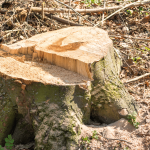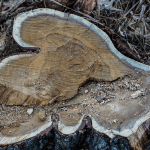Pulling a stump out from a tree trunk is not easy at all, especially when one does not consider using a stump grinder. It is still possible to remove a stump with some extra work and creativity. This article will provide you with a series of recommendations in order to remove tree stumps without grinder.
Assess the Situation
First, it is essential to thoroughly assess the dimensions of the stump, along with how deeply it is buried, as this can influence whether or not you will need a stump grinder. Several factors will influence the approach taken. Additionally, it’s important to gather the essential tools and obtain the necessary permissions.
Safety First
Safety is never optional, and therefore, it is important that you always prioritize safety. It’s important to wear gloves, goggles, and strong boots to avoid cuts by sharp objects and body injuries. Make sure you have a first aid kit available, and be certain you know what you’ll do with the remaining materials after using them to cut the stump. Also, avoid handling the excess material without protection on your hands.
Mechanical Methods
Manual Digging
If the stump is not too big, then you can physically remove the stump. This method will involve the digging around the stump so as to expose the root of the tree that needs to be extracted.
1. Dig Around the Stump: Use a shovel to dig around the stump in order to outline it. Ensure that you sever all branching roots that come out of the stump.
2. Dig Deep: It is wise to dig around the stump, while ensuring that the roots are gradually uncovered, and it is desirable to get at least one foot below the stump.
3. Swinging the Stump: As the roots come into view, try using a shovel or a wooden plank to then place under the stump, and push it to apply force to rock the stump. This action will help make the roots easy to lift since it will have made the roots weaker and looser.
4. Take Them Out: When you have used enough force, you must dislodge the stump from the ground. This could take quite a while if the roots go deep to the ground, or it may take a long time if the stumps are large in size.
Cutting Down
For larger stumps, the removal process may be easier if the stumps are sawed into smaller sizes.
1. Cut the Stump: Keep the stump low to the ground, as this will make it easier to remove from its base and will help in moving the pieces effortlessly.
2. Further Chopping: After cutting the stump, it is also advisable to reduce the size by hand or by using other tools, such as mattock or an axe.
3. Pull Out the Pieces: As for disassembly, pull out each piece from the ground. You might need to use a shovel to help lift them up, and you are likely to need a pickup truck to transport them.
Stump Puller
A manual stump puller is a tool that is used for removing stumps from the ground without grinding. With this piece of equipment, the concepts of leverage and mechanical advantage are employed in pulling the stumps.
1. Position the Puller: Ensure that the stump puller is positioned around the stump. The larger the wheel, the more leverage one will gain.
2. Tighten the Straps: Buckle the stump to its secure position with the help of the straps that are available with the machine. Firmly attach to the puller before carrying out any activity.
3. Pull: Rotating the wheel at the handle of the puller should cause the teeth to lift the stump above the ground.
Chemical Methods
Commercial Stump Removers
Chemical stump removers will help you to work the stump over the course of several months and this will enhance the process of decomposition.
1. Select a product: Acquire a suitable chemical stump remover from your local garden center. Follow the provided instructions on the packaging.
2. Drill holes: Simply drill several holes on the top notch of the stump and pour the remover into those holes. After cutting it to the desired height, to increase decomposition, cover it with a tarp so as to prevent water loss.
3. Wait: Let the stump to decay for a couple of weeks and do not disturb it. Check periodically and reapply the chemical when needed.
4. Take out the stump: When the stump is soft to the touch, cut it with the shovel and take it out from the soil.
Homemade Solutions
If you do not have any of the above or prefer a more natural remedy, you can use products that are found at home.
1. Make a Paste: Dissolve potassium nitrate, which is easily available in garden stores, in water to get a paste.
2. Apply the Paste: Spread the paste on the stump and the drill holes to provide a channel that guides the paste deeper.
3. Flexibility: Another option is to leave a stump to dry and cure, and because it becomes rigid, water cannot get to it easily. Wait for several weeks before all the stump material decomposes and disappears.
4. Remove the Stump: After the stump has been softened, cut it and remove it with a shovel.
Biological Methods
Nitrogen-Rich Mulch
Applying nitrogen-rich mulch will play a significant role on the fungi and microorganisms which decomposes the wood.
1. Mulch the Stump: It is important to put nitrogen-rich mulch around the stump to conceal it; this material may include grass clippings or manure.
2. Water Regularly: Irrigate the material to increase decomposition rates.
3. Time Consuming: This approach can take time, potentially several months, to reach a significant level of decomposition of the stump.
4. To Remove: As soon as the stump becomes soft, pull it out using a shovel.
Vinegar and Dish Soap
The decomposition process can be done with a solution made from a one-part vinegar and one-part dish soap.
1. Mix the Solution: The solution that is required here is an equal ratio of vinegar and water with some dish soap added to it.
2. Reapply the Solution: Pour the solution into the stump.
3. Drill Holes: Make holes into the stump to facilitate access of the solution.
4. Wait: Let it remain in the stump and allow it decompose. This method can take several months depending on the severity of the condition.
5. Remove: When the stump becomes soft when all the sap has risen, you should then use a shovel to remove the stump.



